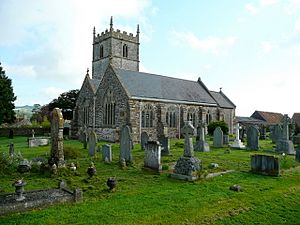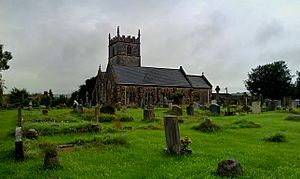Church of St Mary the Virgin, Stanton Drew facts for kids
Quick facts for kids Church of St Mary the Virgin |
|
|---|---|
 |
|
| Location | Stanton Drew, Somerset, England |
| Built | 13th century |
|
Listed Building – Grade II*
|
|
| Official name: Church of St. Mary | |
| Designated | 21 September 1960 |
| Reference no. | 1136209 |
| Lua error in Module:Location_map at line 420: attempt to index field 'wikibase' (a nil value). | |
The Church of St Mary the Virgin is an old and beautiful church located in a village called Stanton Drew, in Somerset, England. It was built a very long time ago, in the 13th century. This church is considered a special historical building, known as a Grade II* listed building. This means it's very important and protected because of its history and architecture.
Exploring the Church
Inside the Church
When you step inside the church, you can see many interesting features. In the north part of the church, there is a very old font. This font is a large stone bowl used for baptisms. It was made in the Norman style, which was popular many centuries ago.
Further inside, you might notice small steps behind a glass door. These steps once led up to a "rood loft." A rood loft was a special balcony or platform that used to be in churches. It was often used by choirs or for reading parts of the service.
While parts of the church date back to the 13th and 14th centuries, much of what you see today was changed in 1847. During this time, the south, west, and north walls were rebuilt. However, a section near the Lady Chapel was kept as it was. The main parts of the church, like the nave (the central area) and the tower arches, were rebuilt in the 15th century.
Outside the Church
The churchyard around the Church of St Mary the Virgin is also very historic. You can find several old monuments there. These are like special memorials for people who have passed away. Some of these monuments are also listed as important historical items, just like the church itself.
Even the entrance to the churchyard is special. The large stone pillars, gates, and the decorative archway at the north-east entrance are also protected. They add to the historical feel of this ancient place.


